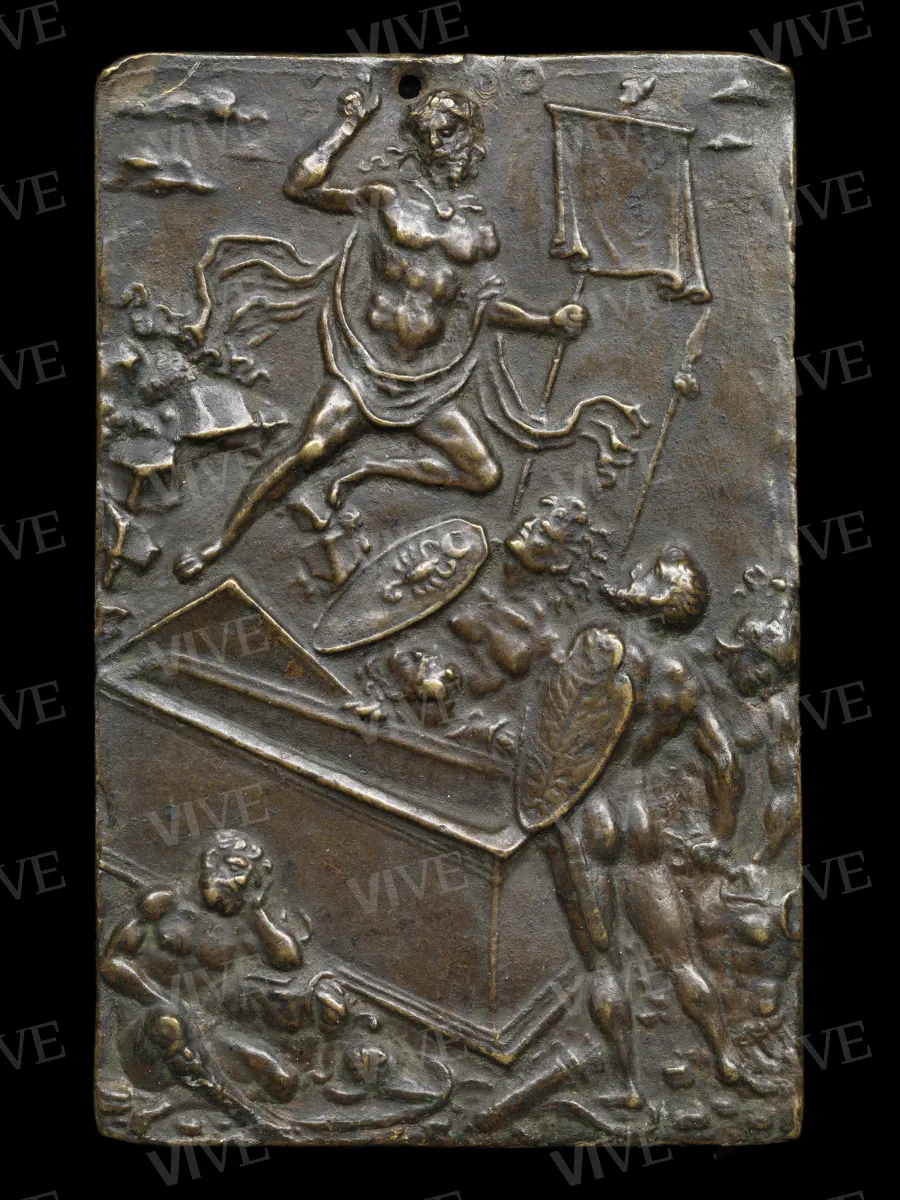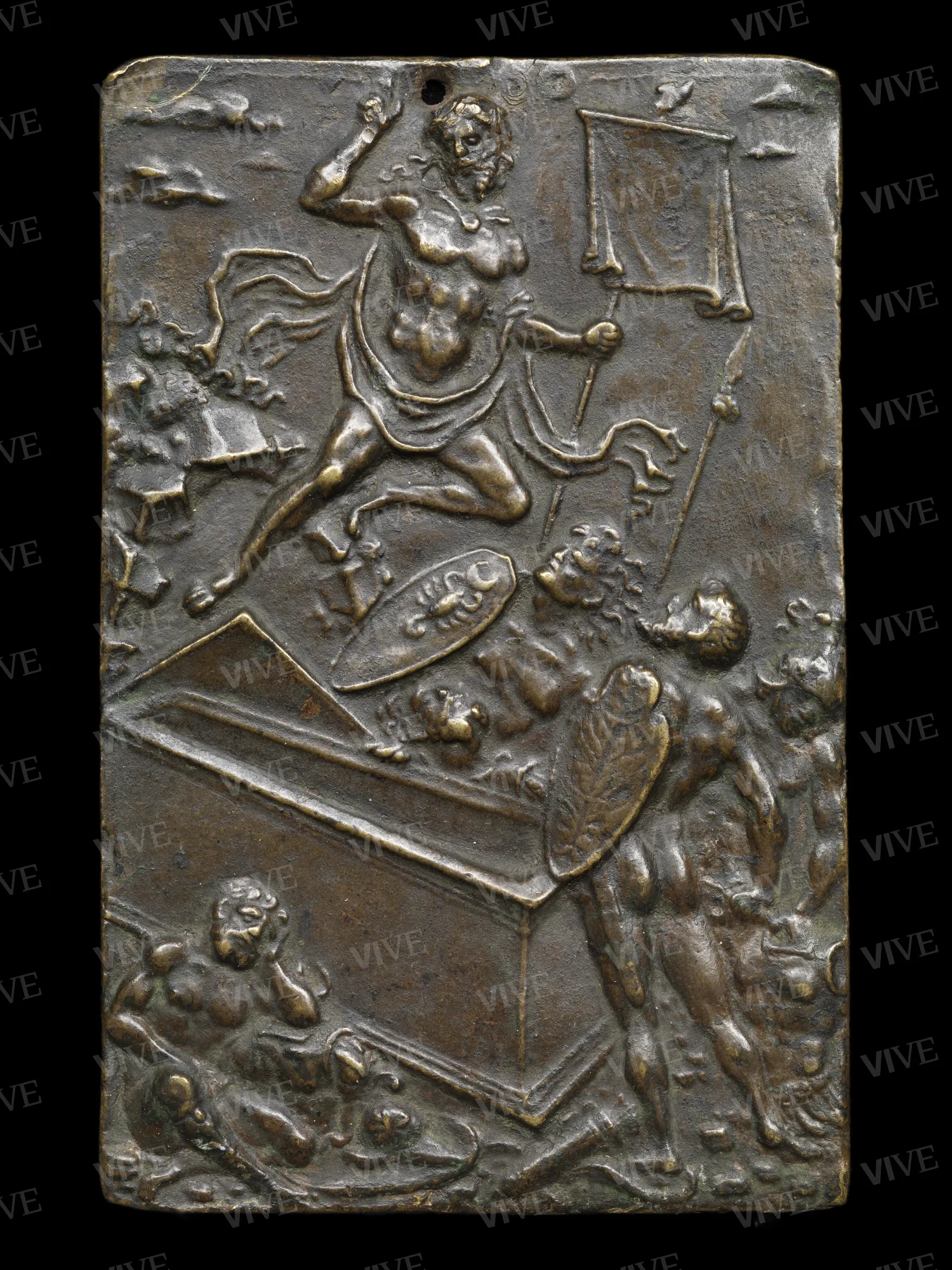Resurrection of Christ
Galeazzo Mondella called Il Moderno C. 1497-1500
The Resurrection of Christ, created by Veronese goldsmith Galeazzo Mondella, known as Il Moderno, dates back to the late fifteenth century. The plaque depicts Christ emerging triumphant from the tomb, observed by the soldiers guarding it. One soldier's shield features a scorpion, which symbolises those who did not recognise the divinity of Christ.
The Resurrection of Christ, created by Veronese goldsmith Galeazzo Mondella, known as Il Moderno, dates back to the late fifteenth century. The plaque depicts Christ emerging triumphant from the tomb, observed by the soldiers guarding it. One soldier's shield features a scorpion, which symbolises those who did not recognise the divinity of Christ.
Details of work
Catalog entry
The plaque depicts the Resurrection, where Christ emerges from the tomb triumphantly, bearing the labarum and bestowing blessings. At his feet, surrounding the tomb, are five soldiers: one is asleep in the foreground, while the others are astonished by the divine appearance. The soldier beneath Christ holds a shield adorned with a scorpion and a crescent moon. In the background, the cave of the tomb and a sky with clouds are visible. Molinier (1886) observed that the soldier, naked from the waist up, also appears in the Crucifixion (inventory number 10830). Pope-Hennessy (1965) suggested that this figure might have been inspired by a printed source, though he did not specify which one. Middeldorf (oral communication cited in Pope-Hennessy 1965) connected the work to the altarpiece painted by Boltraffio and Marco d’Oggiono (around 1497) depicting the Resurrection with Saints Leonard and Lucy. This piece was originally in the church of San Leonardo in Milan and now resides in the Berlin Museums. The connection is suggested by the detail of the lid of the sarcophagus placed diagonally, leaving only one corner visible. Additionally, the iconography of Christ is noted for showing him leaping out of the tomb rather than standing on it, emerging from it, or floating above it, which were common depictions in the fifteenth-century tradition. Mondella (1467–1528) would have promptly drawn his cues for modernity from the first unified space altarpiece created in Lombardy after Leonardo’s Virgin of the Rocks. Conversely, Lewis (1989) identified connections between this work and contemporary Ferrarese painting, hypothesizing that the artist may have stayed in the city of the Este family, and dating the piece to 1487–1490. Specifically, Lewis compared the sleeping soldier to the figure of King David in the upper left of Ercole de’ Roberti’s altarpiece for the church of San Lazzaro in Ferrara, painted in the mid-1470s (formerly housed in the Kaiser Friedrich Museum, Berlin). Rossi (2006), however, recognized Mantegnaesque characteristics in the work, situating its creation around 1490. Warren (2014) subsequently dated it to approximately 1490–1500. Given its connection to the works of Boltraffio and Marco D’Oggiono, the plaque is likely dated to the late fifteenth century. Pope-Hennessy (1965) proposed that the Resurrection was created as a counterpart to the Deposition in the Sepulchre, a theory widely accepted by scholars (Panvini Rosati 1968; Cannata 1982; Jestaz 1997). Symbolically, the scorpion appears frequently in fifteenth-century Crucifixion scenes and a number of Flagellations, such as Pier Francesco Fiorentino’s 1494 painting in the church of Sant’Agostino in San Gimignano. In Christological contexts, the scorpion symbolizes betrayal and refers to those who did not recognize the divinity of Jesus Christ, including pagans and Jews.
The scorpion depicted by Moderno includes the detail of the crescent, which is unique compared to other artistic contexts. This detail may have been copied from ancient gems, such as the one recently sold at auction in Montecarlo (Glyptique Archéologie 2023). Regarding the lower part of Christ’s body, with one left leg outstretched, the other bent, and the fluttering robe, it is believed that the goldsmith used ancient models familiar to artists, such as the reliefs of Mithras (for example, the relief discovered in Fiano Romano now housed in the Louvre, which was studied extensively in the fifteenth century: Bober, Rubinstein 2010, pp. 92–93, n. 46). The piece in the Museo Nazionale di Palazzo Venezia, akin to other small plaques by Il Moderno with Christological scenes (see inv. 10827, inv. 10828, inv. 10830), originates from the Viennese collection of the ambassador Giacinto Auriti (Santangelo 1964; Cannata 1982). Some artifacts feature finely chiseled details on the helmet of the soldier on the ground and on the shield of the soldier seen from behind (for example: Panvini Rosati 1968; Rossi 1974; National Gallery of Washington, inv. 1957.14.299).
Numerous examples can be cited, including those at the Louvre (Molinier 1886; Migeon 1904), Berlin (Bange 1922), the Victoria & Albert Museum (Maclagan 1924), Santa Barbara (Middeldorf, Goetz 1944), the National Gallery of Art in Washington (De Ricci 1931; Cott 1951; Pope-Hennessy 1965; Wilson 1983), the Metropolitan Museum in New York (inv. 25.142.30), the Museo Correr in Venice (Jacobsen 1893), Belluno (Venturi 1910; Jestaz 1997), Vicenza (Banzato 2000), Palazzo Horne in Florence, and Brescia (Rossi 1974; Rossi 2006).
Giulio Pietrobelli
Entry published on 27 March 2025
State of conservation
Good. Natural brown patina.
Provenance
Vienna, Collezione Giacinto Auriti, assembled between 1922 and 1933, no. 9;
Rome, Museo Nazionale di Palazzo Venezia, donated in 1963.
References
Molinier Émile, Les bronzes italiens de la Renaissance. Les plaquettes. Catalogue raisonné, Paris 1886, I, pp. 134-135, n. 180;
Jacobsen Emil, Plaketten im Museo Correr zu Venedig, in «Repertorium für Kustwissenschaft», 16, 1893, p. 65;
Migeon Gaston (a cura di), Musée National du Louvre. Catalogue des bronzes & cuivres du Moyen Âge, de la Renaissance et des temps modernes, Paris 1904, pp. 246-247, n. 304;
Venturi Lionello, I bronzi del Museo Civico di Belluno, in «Bollettino d’arte», IV, 1910, 9, pp. 353-366, nota 3;
Bange Ernst Friedrich (a cura di), Die Italienischen Brozen der Renaissance und des Barock: Riliefs und Plaketten, Berlin 1922, II, p. 63 nn. 458-459, tav. 46;
Maclagan Eric, Victoria & Albert Museum. Catalogue of Italian Plaquettes, London 1924, p. 31, n. 7421-1860 e 429-1910;
De Ricci Seymour, The Gustave Dreyfus collection. Reliefs and Plaquettes, Oxford 1931, p. 136, n. 175;
Imbert Eugenio, Morazzoni Giuseppe (a cura di), Le placchette italiane. Secolo XV-XIX. Contributo alla conoscenza della placchetta italiana, Milano 1941, p. 57 n. 116, tav. XVII;
Middeldorf Ulrich, Goetz Oswald, Medals and Plaquettes from the Sigmund Morgenroth Collection, Chicago 1944, pp. 34, n. 235;
Cott Perry, Renaissance Bronzes: Statuettes, Reliefs and Plaquettes, Medals and Coins from The Kress Collection, Washington 1951, p. 151;
Santangelo Antonino, Museo di Palazzo Venezia. La collezione Auriti. Piccoli bronzi, placchette, incisioni e oggetti d’uso, Roma 1964, pp. 37;
Pope-Hennessy John, Renaissance Bronzes from the Samuel Kress H. Collection. Reliefs, Plaquettes, Statuettes, Utensils and Mortars, London 1965, p. 47, n. 151, fig. 177;
Panvini Rosati Franco, Medaglie e placchette italiane dal Rinascimento al XVIII secolo, Roma 1968, pp. 71-72, n. 31, fig. 31;
Rossi Francesco (a cura di), Musei Civici di Brescia. Placchette secoli XV-XIX, Vicenza 1974, pp. 27-28, nn. 33-34, figg. 33-34;
Cannata Pietro (a cura di), Rilievi e placchette dal XV al XVIII secolo, catalogo della mostra (Roma, Museo Nazionale di Palazzo Venezia, febbraio-aprile 1982), Roma 1982, p. 51, n. 28;
Wilson Carolyn, Renaissance Small Bronze Sculpture and Associated Decorative Arts at the National Gallery of Art. Washington, Washington 1983, p. 107, n. 14;
Lewis Douglas, The Plaquettes of Moderno and His Followers, in «Studies in the History of Art», 22, 1989, pp. 105-141;
Jestaz Bertrand, Catalogo del Museo Civico di Belluno. Le placchette e i piccoli bronzi, Belluno 1997, p. 55, n. 28, p. 154, fig. 28;
Banzato, in Banzato Davide, Beltramini Maria, Gasparotto Davide, Placchette, bronzetti e cristalli incisi dei Musei Civici di Vicenza. Secoli XV-XVIII, catalogo della mostra (Caltanissetta, Cripta della Cattedrale, 16 settembre-12 novembre 2000), Verona 2000, p. 65, n. 33, p. 125, n. 33;
Rossi, in Rossi Francesco (a cura di), Placchette e rilievi di bronzo nell’età di Mantegna, catalogo della mostra (Mantova, Museo della Città, Palazzo San Sebastiano, 16 settembre 2006-14 gennaio 2007), Milano 2006, pp. 53-55;
Bober Phyllis Pray, Rubinstein Ruth, Renaissance Artists & Antique Sculpture, [London] 2010;
Warren Jeremy (a cura di), Medieval and Renaissance Sculpture. A Catalogue of the Collection in the Ashmolean Museum, Oxford. Volume 3. Plaquettes, Oxford 2014, pp. 846-847, n. 302;
Glyptique Archéologie, Hôtel des Ventes de Monte-Carlo, mardi 7 février 2023, p. 131 n. 281.












